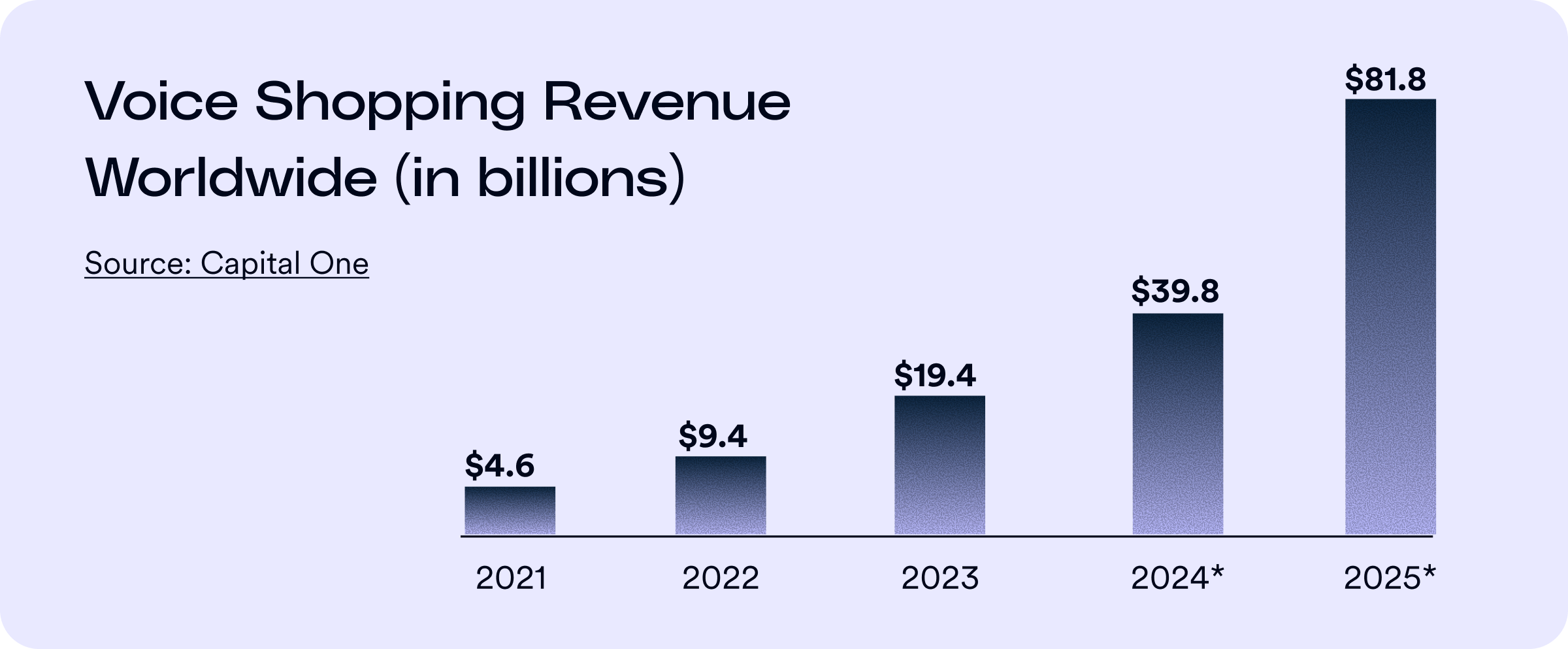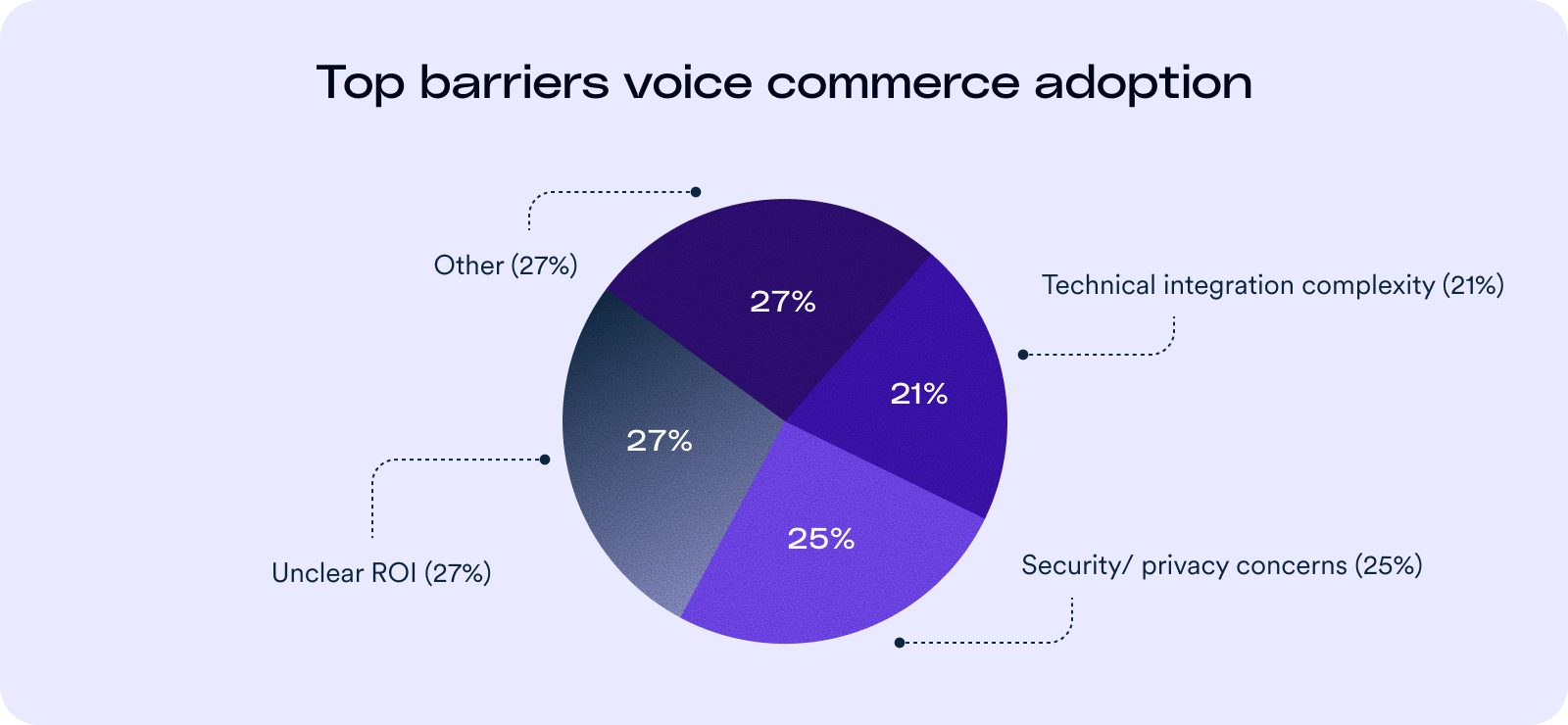About the research
Our eCommerce trends survey, conducted with Qualtrics, non-profit leaders, and disability community organizations, captured insights from over 300 eCommerce leaders and members of the disability community. The findings show that while adoption of voice commerce is accelerating, many retailers still view it primarily as a convenience feature, overlooking its origins as an accessibility tool and its potential to expand independence, inclusivity, and conversions.
The main question:“Should eCommerce leaders incorporate voice commerce now, or is it still too early?”
Market momentum: From niche to necessity
Voice commerce is no longer experimental—it’s already shaping shopping behavior at scale. Nearly half of U.S. consumers have shopped by voice, with the market having reachied $81.8B in 2025. On top of that, 81% of Americans use voice technology weekly, showing just how deeply it has entered everyday life. For businesses, the impact is real: eCommerce companies offering voice checkout report conversion lifts of up to 20%. What began as a niche accessibility tool has become a mainstream growth engine.

Yet adoption among mid-market brands is uneven. Our research shows that 40% of mid-market eCommerce businesses are still not using voice commerce. But among those that have, momentum is clear: 58% say more than a quarter of their orders are already initiated via voice. This acceleration follows a familiar pattern in commerce: innovations that begin as accessibility tools often grow into mainstream behaviors.
From accessibility breakthrough to mainstream behavior
Innovation doesn’t always start in the boardroom—it often begins with accessibility. Closed captions were created for people with hearing loss; today, they’re everywhere from TikTok to Times Square billboards. Curb cuts were designed for wheelchair users; now they serve parents with strollers and travelers with luggage. Voice commands were pioneered to help people with mobility and visual disabilities; now they’re how millions of us set alarms, send messages, and reorder groceries.
84% of surveyed leaders believe that voice commerce benefits people beyond those with disabilities |
Voice commerce is the next chapter of that story: what began as an accessibility breakthrough has become one of the fastest-moving forces in eCommerce. 84% of surveyed leaders believe that voice commerce benefits people beyond those with disabilities. The message is clear: if you wait for accessibility features to “go mainstream,” you’re already too late. The proof is in the numbers:

The risks of waiting are high
The biggest players are already reshaping consumer expectations. Amazon now enables grocery orders across Whole Foods, Amazon Fresh, Grubhub, and Uber Eats entirely by voice, making reordering nearly invisible to the customer.Walmart has launched a voice commerce system that learns and adapts in real time to shopper preferences, setting a new standard for personalization in voice-first eCommerce.
This shift is accelerating fast: Amazon Alexa shopping commands surged 300% year-over-year after its AI-powered upgrade, showing how quickly consumers are embracing voice-first interactions. When customers experience this level of frictionless convenience, they carry those expectations everywhere.
And the stakes are even higher: brands that aren’t optimized for voice risk being invisible to assistants like Alexa or Google. When a shopper says “Order coffee pods,” the assistant only surfaces optimized products—handing competitors the sale.
| Brands that aren’t optimized for voice risk being invisible to assistants like Alexa or Google. |
Yet despite this momentum, adoption isn’t universal. Four in ten mid-market eCommerce brands still haven’t implemented voice commerce — and among those holding back, nearly half point to technical or security complexities as the biggest barriers.

Accessibility makes it work
Voice commerce was born out of accessibility—and it remains most powerful when inclusivity stays central.
When done right, it delivers:
- Hands-free independence for low-vision shoppers
- Reduced friction for people with mobility disabilities, who no longer need to navigate tiny menus or clicks
- Simplified checkout for customers with cognitive disabilities, bypassing CAPTCHAs and confusing forms
When done poorly, it creates barriers:
- Silent failures if aria-live updates aren’t coded—screen readers don’t announce errors like failed payments
- No text fallback shuts out people with hearing loss or speech disorders
- Missing aria-live updates mean screen readers can’t announce key steps
These aren’t minor usability issues—they are make-or-break barriers that push customers out of the funnel. The opportunity lies in embracing accessibility from the start. When voice commerce is inclusive, it benefits everyone. When it isn’t, it risks excluding millions of shoppers.
““Voice commerce is incredible because, without it, I’m often locked out of even having a chance to shop independently. With it, I gain access and a sense of freedom.“ - Josh Basile Esq., Community Relations Manager, accessiBe |
This is where tools like accessFlow and MTCR help: validating aria updates, transcripts, and error handling with real-world assistive technology, and remediating gaps before customers hit them.
This contrast highlights the gap: eCommerce leaders frame voice as convenience, while disability communities see it as a lifeline. Companies that bridge this gap will win loyalty that others can’t.
Key takeaways: Why leaders should act now
Yes — you should get into the voice commerce game. Adoption is already mainstream, the risks of waiting are high, and the opportunity is a competitive advantage. But winning with voice means more than just enabling the channel — it means making it accessible. When you build voice commerce with accessibility best practices, you stay ahead of competitors and deliver an experience that works for every shopper.
- Accessibility drives adoption
Every accessibility breakthrough—captions, curb cuts, voice commands—becomes mainstream. Voice commerce is no different. Acting now means shaping tomorrow’s standard. - Structured data is visibility
In a voice-first world, unstructured catalogs don’t exist. Rich metadata and semantic tags make products discoverable by assistants—and usable by all shoppers. - Choice creates trust
Not everyone can or wants to use voice. Pairing voice with text fallback and confirmations ensures no shopper is excluded—and signals that your brand designs for everyone. - Reliability builds habits
Voice only sticks if it works every time. Clear prompts and error handling transform it from novelty into a repeatable, trusted behavior. - Inclusion is proven in practice
Accessibility isn’t theory—it’s tested in real life. Running flows with assistive technology users uncovers the gaps internal QA can’t see. Tools like accessFlow enable continuous validation, while MTCR provides expert remediation at scale. - Early movers set the standard
Amazon and Walmart are training consumers to expect seamless, accessible voice commerce. Mid-market leaders can’t outspend them—but they can out-include them.
“Retailers think of voice as convenience. For us, it’s independence. But only if it’s designed right.” — accessiBe Product Advisory Board member |
Closing insight
Trends don’t just shift how people shop. They reshape who gets to shop. Voice commerce proves that when you design for everyone, you’re not chasing the future—you’re creating it.
Frequently asked questions about voice commerce & eCommerce accessibility
Q1. What is voice commerce and why is it becoming important in eCommerce?
A1. Voice commerce refers to shopping experiences where customers use voice commands—through virtual assistants or smart devices—to search for products, get recommendations, and complete purchases. As more consumers adopt hands-free, conversational technology, voice-enabled shopping is becoming a major competitive channel.
Q2. How does accessibility impact voice commerce readiness?
A2. Accessibility is essential because voice assistants rely on clean, structured, and semantically meaningful content. When product data, navigation, and page structure follow WCAG principles—using alt text, proper heading hierarchy, semantic markup, and ARIA attributes—voice systems can reliably interpret and surface your products. Without accessibility, your content may be unreadable to both assistive technologies and voice platforms.
Q3. What business benefits can voice commerce bring to eCommerce brands?
A3. Voice commerce can expand reach, streamline the path to purchase, boost conversions, and make shopping more accessible to users with disabilities. It also positions brands to meet rising customer expectations for hands-free and conversational experiences.
Q4. What risks do brands face if they delay voice commerce or ignore accessibility?
A4. Risks include diminished visibility in voice-enabled search, lower conversions, exclusion of users with disabilities, and falling behind competitors who offer accessible, voice-friendly experiences. As voice adoption grows, inaccessible sites become harder for both people and AI systems to use.
Q5. What accessibility barriers most commonly undermine voice-driven shopping experiences?
A5. Key barriers include missing or incorrect alt text, poor heading structure, unlabeled buttons, inaccessible menus, keyboard traps, incomplete ARIA roles, and checkout flows that screen readers cannot interpret. These issues prevent voice systems from understanding content and inhibit users’ ability to complete tasks.
Q6. What steps should eCommerce brands take to prepare for voice commerce while ensuring accessibility?
A6. Brands should audit their product catalog and site structure for accessibility, add descriptive alt text, ensure semantic HTML and ARIA labeling, optimize metadata, test voice and assistive-technology workflows, and integrate accessibility into ongoing content and development processes.
Q7. How can accessiBe help brands get voice-ready through accessibility?
A7. accessiBe provides scanning, remediation, and ongoing monitoring tools that help ensure your product data and site structure are accessible and interpretable by both assistive technologies and AI-driven voice systems. This helps improve discoverability, user experience, and compliance.
Q8. What’s the main takeaway for eCommerce leaders about voice commerce and accessibility?
A8. Voice commerce is expanding fast, and accessibility is what makes it work. Ensuring your site is accessible enhances user experience, improves AI interpretability, and prepares your brand for the future of hands-free shopping.


